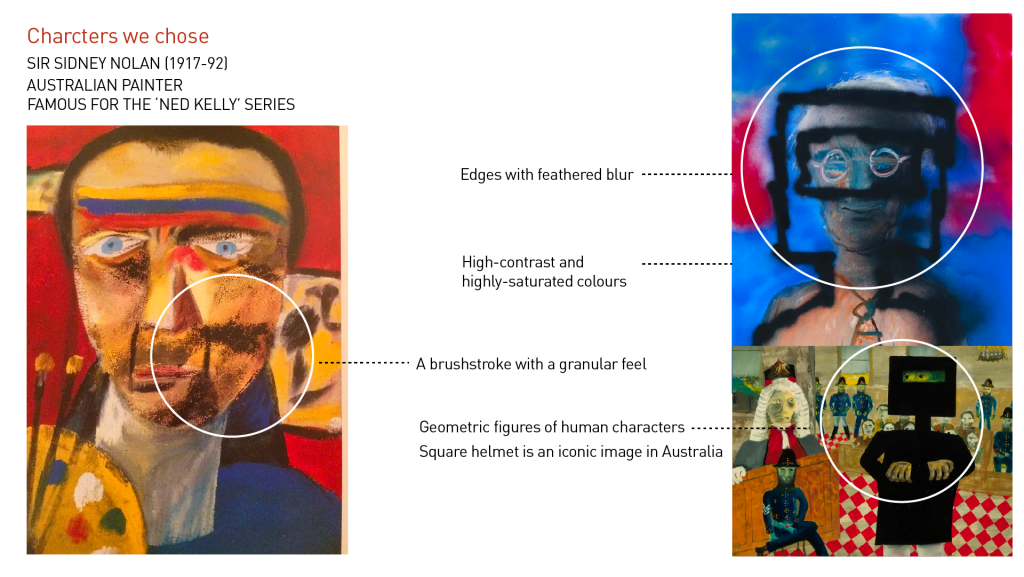After confirming that our story takes place in Highgate Cemetery, we needed to research the people buried there and find their stories and connections.
Due to the majority of our time being spent on organizing and advancing the Departure Lounge project during the Easter holidays, and with three members of the group also being busy with the Departure Lounge project, Critical Practice was delayed and the group members’ ideas were never unified, which resulted in the final story and plan being established only this week.
My story iterations:
On the first day of the semester was mid-crit, and before mid-crit, I conducted research and developed a VR experience for related artists based on the rough plan discussed previously.


Because the original plan was to play around with some interesting visual effects, I did some research on the artists on the list and selected four artists with different styles. I analyzed their works and extracted the most prominent features.





In terms of the story, after researching Highgate, “Highgate Cemetery Vampire” caught my interest, and I developed two plans.
Plan A is to explore different possibilities for the player character and develop the story.
Player could be
- Vampire
- Dead
- Live Traveller
- Ghost Hunter
- Grave Keeper



After watching “Last Winter We Parted”, Ria and I really liked its narrative structure. So we applied the structure of the film to our own concept.

The Story has three perspectives for the reader to follow in order. Each perspective tells the individual story of the character and their shared experience.

During the discussion with our team members, we were more inclined towards the second proposal. Mostafa suggested the idea of “artists fighting for taking over the cemetery with their visual style.” I found this concept very intriguing, and so we attempted to incorporate it into our story.
以下是我们的mid-term crit的slides
https://docs.google.com/presentation/d/1gvQZZXUNZ4pxIh10j1pPFCMMODpGVC1AsNIAdZuCzJQ/edit?usp=sharing
In the Crit, we discussed with Ana and Klauz the development directions of AR and VR. Klauz raised a question about the player’s task: “Why must they keep in order?” What would happen if they didn’t follow the order? What if a player really likes a particular artist?
Klauz suggested the possibility of adding a new character, such as Edward Lear, as a mischief-maker who is a source of chaos.
I found these questions very useful for the development of our story, so we each did our research and continued the discussion.
My improvement based on the questions and suggestions raised during Crit
#How do we guide the player to complete tasks, and what are the player’s tasks?
#Why is it important to keep in order?
#What is the core game mechanic?
This is a first-person VR experience.
The Player will be a graveyard keeper. When they enter the game, they’ll find themselves in the keeper’s work shed, where they can find a work manual, graveyard management logs, and information on the deceased.
The work manual outlines your task of maintaining order in the cemetery, while the management logs reveal that Edward Lear has disrupted the once an orderly graveyard, leaving behind a string of nonsensical poetry as guidance. As a result, they need to remedy the damaged areas. The work manual contains blueprints, but they too have been damaged.
The player must consult the information on the deceased, use their knowledge of the artist to deduce the missing parts of the blueprints and construct each artist’s posthumous room. The goal is to trap the artists in their graves and prevent them from escaping, in case the deceased cause another Highgate Vampire incident.
I researched Edward Lear and found his limerick style interesting, so I used ChatGPT to generate a limerick poem based on our story.





My teammates were not satisfied with the mechanism of “not letting the artists come out,” so we revised the order based on this. Below is our final player journey.

Thoughts on AR Experience

But we were concerned about the application of Geolocation, so we added a filter as an alternative plan. We hoped that Pitor could help us. After sharing with Pitor, we were informed that GPS requires a large amount of investment and the accuracy is only 2 meters. He helped us adjust the plan to a gamified AR experience using basic GPS tracking. The following is our plan:
- Guide people on a fundamental way to find the grave
- Put the image target on the grave
- Trigger face filter -> a portal to see rooms
Pitor informed us that when testing GPS, we should use two devices for testing, one Android and one iOS.
I think it’s odd and unnecessary to use the rear camera to scan the target and then interact with the filter using the front camera, so we want to use element consistency and replace the filter with an artist room.
On April 19th, Ana gave us a lecture on Transmedia Narrative, which was very inspiring for us. Based on the principles of Composition, Continuity, and Consistency, we made further revisions to our AR plan.
The following is our latest plan.
AR experience
The Player can choose to be Edward Lear or Grave Keeper
Edward Lear – hide objects
Grave Keeper – Find objects and return
(See a map or navigation to the grave)
- Enter the portal
- Pick up moveable items
- Move your items into the basket
- Physically at the position and hide
- See a list of items in the cemetery
- Marked information on the items – it belongs to Lucian
- Return things back to the portal